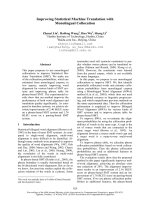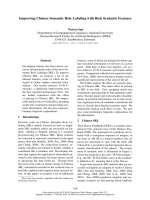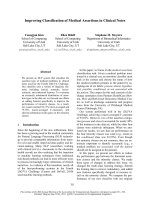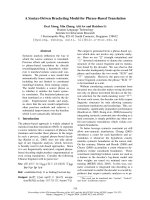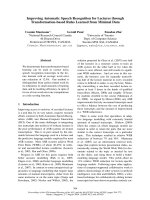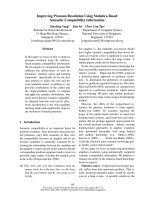Báo cáo khoa học: "Improving Data Driven Wordclass Tagging by System Combination" pptx
Bạn đang xem bản rút gọn của tài liệu. Xem và tải ngay bản đầy đủ của tài liệu tại đây (614.73 KB, 7 trang )
Improving Data Driven Wordclass Tagging
by System Combination
Hans van Halteren
Dept. of Language and Speech
University of Nijmegen
P.O. Box 9103
6500 HD Nijmegen
The Netherlands
Jakub Zavrel, Walter Daelemans
Dept. of Computational Linguistics
Tilburg University
P.O. Box 90153
5000 LE Tilburg
The Netherlands
,
Abstract
In this paper we examine how the differences in
modelling between different data driven systems
performing the same NLP task can be exploited
to yield a higher accuracy than the best indi-
vidual system. We do this by means of an ex-
periment involving the task of morpho-syntactic
wordclass tagging. Four well-known tagger gen-
erators (Hidden Markov Model, Memory-Based,
Transformation Rules and Maximum Entropy)
are trained on the same corpus data. Af-
ter comparison, their outputs are combined us-
ing several voting strategies and second stage
classifiers. All combination taggers outperform
their best component, with the best combina-
tion showing a 19.1% lower error rate than the
best individual tagger.
Introduction
In all Natural Language Processing (NLP)
systems, we find one or more language
models which are used to predict, classify
and/or interpret language related observa-
tions. Traditionally, these models were catego-
rized as either rule-based/symbolic or corpus-
based/probabilistic. Recent work (e.g. Brill
1992) has demonstrated clearly that this cat-
egorization is in fact a mix-up of two distinct
Categorization systems: on the one hand there is
the representation used for the language model
(rules, Markov model, neural net, case base,
etc.) and on the other hand the manner in
which the model is constructed (hand crafted
vs. data driven).
Data driven methods appear to be the more
popular. This can be explained by the fact that,
in general, hand crafting an explicit model is
rather difficult, especially since what is being
modelled, natural language, is not (yet) well-
understood. When a data driven method is
used, a model is automatically learned from the
implicit structure of an annotated training cor-
pus. This is much easier and can quickly lead
to a model which produces results with a 'rea-
sonably' good quality.
Obviously, 'reasonably good quality' is not
the ultimate goal. Unfortunately, the quality
that can be reached for a given task is limited,
and not merely by the potential of the learn-
ing method used. Other limiting factors are the
power of the hard- and software used to imple-
ment the learning method and the availability of
training material. Because of these limitations,
we find that for most tasks we are (at any point
in time) faced with a ceiling to the quality that
can be reached with any (then) available ma-
chine learning system. However, the fact that
any given system cannot go beyond this ceiling
does not mean that machine learning as a whole
is similarly limited. A potential loophole is that
each type of learning method brings its own 'in-
ductive bias' to the task and therefore different
methods will tend to produce different errors.
In this paper, we are concerned with the ques-
tion whether these differences between models
can indeed be exploited to yield a data driven
model with superior performance.
In the machine learning literature this ap-
proach is known as ensemble, stacked, or com-
bined classifiers. It has been shown that, when
the errors are uncorrelated to a sufficient degree,
the resulting combined classifier will often per-
form better than all the individual systems (Ali
and Pazzani 1996; Chan and Stolfo 1995; Tumer
and Gosh 1996). The underlying assumption is
twofold. First, the combined votes will make
the system more robust to the quirks of each
learner's particular bias. Also, the use of infor-
mation about each individual method's behav-
iour in principle even admits the possibility to
491
fix collective errors.
We will execute our investigation by means
of an experiment. The NLP task used in the
experiment is morpho-syntactic wordclass tag-
ging. The reasons for this choice are several.
First of all, tagging is a widely researched and
well-understood task (cf. van Halteren (ed.)
1998). Second, current performance levels on
this task still leave room for improvement:
'state of the art' performance for data driven au-
tomatic wordclass taggers (tagging English text
with single tags from a low detail tagset) is 96-
97% correctly tagged words. Finally, a number
of rather different methods are available that
generate a fully functional tagging system from
annotated text.
1 Component taggers
In 1992, van Halteren combined a number of
taggers by way of a straightforward majority
vote (cf. van Halteren 1996). Since the compo-
nent taggers all used n-gram statistics to model
context probabilities and the knowledge repre-
sentation was hence fundamentally the same in
each component, the results were limited. Now
there are more varied systems available, a va-
riety which we hope will lead to better com-
bination effects. For this experiment we have
selected four systems, primarily on the basis of
availability. Each of these uses different features
of the text to be tagged, and each has a com-
pletely different representation of the language
model.
The first and oldest system uses a tradi-
tional trig-ram model (Steetskamp 1995; hence-
forth tagger T, for Trigrams), based on context
statistics
P(ti[ti-l,ti-2)
and lexical statistics
P(tilwi)
directly estimated from relative cor-
pus frequencies. The Viterbi algorithm is used
to determine the most probable tag sequence.
Since this model has no facilities for handling
unknown words, a Memory-Based system (see
below) is used to propose distributions of po-
tential tags for words not in the lexicon.
The second system is the Transformation
Based Learning system as described by Brill
(19941; henceforth tagger R, for Rules). This
1 Brill's system is available as a collec-
tion of C programs and Perl scripts at
ftp ://ftp. cs. j hu. edu/pub/brill/Programs/
RULE_BASED_TAGGER_V. I. 14. tar. Z
system starts with a basic corpus annotation
(each word is tagged with its most likely tag)
and then searches through a space of transfor-
mation rules in order to reduce the discrepancy
between its current annotation and the correct
one (in our case 528 rules were learned). Dur-
ing tagging these rules are applied in sequence
to new text. Of all the four systems, this one
has access to the most information: contextual
information (the words and tags in a window
spanning three positions before and after the
focus word) as well as lexical information (the
existence of words formed by suffix/prefix addi-
tion/deletion). However, the actual use of this
information is severely limited in that the indi-
vidual information items can only be combined
according to the patterns laid down in the rule
templates.
The third system uses Memory-Based Learn-
ing as described by Daelemans
et al.
(1996;
henceforth tagger M, for Memory). During
the training phase, cases containing informa-
tion about the word, the context and the cor-
rect tag are stored in memory. During tagging,
the case most similar to that of the focus word
is retrieved from the memory, which is indexed
on the basis of the Information Gain of each
feature, and the accompanying tag is selected.
The system used here has access to information
about the focus word and the two positions be-
fore and after, at least for known words. For
unknown words, the single position before and
after, three suffix letters, and information about
capitalization and presence of a hyphen or a
digit are used.
The fourth and final system is the MXPOST
system as described by Ratnaparkhi (19962;
henceforth tagger E, for Entropy). It uses a
number of word and context features rather sim-
ilar to system M, and trains a Maximum En-
tropy model that assigns a weighting parameter
to each feature-value and combination of fea-
tures that is relevant to the estimation of the
probability
P(tag[features).
A beam search is
then used to find the highest probability tag se-
quence. Both this system and Brill's system are
used with the default settings that are suggested
in their documentation.
2Ratnaparkhi's Java implementation of this sys-
tem is available at
pub/adwait/jmx/
492
2 The data
The data we use for our experiment consists of
the tagged LOB corpus (Johansson 1986). The
corpus comprises about one million words, di-
vided over 500 samples of 2000 words from 15
text types. Its tagging, which was manually
checked and corrected, is generally accepted to
be quite accurate. Here we use a slight adapta-
tion of the tagset. The changes are mainly cos-
metic, e.g. non-alphabetic characters such as
"$" in tag names have been replaced. However,
there has also been some retokenization: geni-
tive markers have been split off and the negative
marker "n't" has been reattached. An example
sentence tagged with the resulting tagset is:
The ATI singular or plural
article
Lord NPT singular titular
noun
Major NPT singular titular
noun
extended VBD past tense of verb
an AT singular article
invitation NN singular common
noun
to IN preposition
all ABN pre-quantifier
the ATI singular or plural
article
parliamentary JJ adjective
candidates NNS plural common
noun
SPER period
The tagset consists of 170 different tags (in-
cluding ditto tags 3) and has an average ambigu-
ity of 2.69 tags per wordform. The difficulty of
the tagging task can be judged by the two base-
line measurements in Table 2 below, represent-
ing a completely random choice from the poten-
tial tags for each token (Random) and selection
of the lexically most likely tag (LexProb).
For our experiment, we divide the corpus into
three parts. The first part, called Train, consists
of 80% of the data (931062 tokens), constructed
3Ditto tags are used for the components of multi-
token units, e.g. if "as well as" is taken to be a coor-
dination conjunction, it is tagged "as_CC-1 well_CC-2
as_CC-3", using three related but different ditto tags.
by taking the first eight utterances of every ten.
This part is used to train the individual tag-
gers. The second part, Tune, consists of 10% of
the data (every ninth utterance, 114479 tokens)
and is used to select the best tagger parameters
where applicable and to develop the combina-
tion methods. The third and final part, Test,
consists of the remaining 10% (.115101 tokens)
and is used for the final performance measure-
ments of all tuggers. Both Tune and Test con-
tain around 2.5% new tokens (wrt Train) and a
further 0.2% known tokens with new tags.
The data in Train (for individual tuggers)
and Tune (for combination tuggers) is to be the
only information used in tagger construction:
all components of all tuggers (lexicon, context
statistics, etc.) are to be entirely data driven
and no manual adjustments are to be done. The
data in Test is never to be inspected in detail
but only used as a benchmark tagging for qual-
ity measurement. 4
3 Potential for
improvement
In order to see whether combination of the com-
ponent tuggers is likely to lead to improvements
of tagging quality, we first examine the results
of the individual taggers when applied to Tune.
As far as we know this is also one of the first
rigorous measurements of the relative quality of
different tagger generators, using a single tagset
and dataset and identical circumstances.
The quality of the individual tuggers (cf. Ta-
ble 2 below) certainly still leaves room for im-
provement, although tagger E surprises us with
an accuracy well above any results reported so
far and makes us less confident about the gain
to be accomplished with combination.
However, that there is room for improvement
is not enough. As explained above, for combi-
nation to lead to improvement, the component
taggers must differ in the errors that they make.
That this is indeed the case can be seen in Ta-
ble 1. It shows that for 99.22% of Tune, at least
one tagger selects the correct tag. However, it
is unlikely that we will be able to identify this
4This implies that it is impossible to note if errors
counted against a tagger are in fact errors in the bench-
mark tagging. We accept that we are measuring quality
in relation to a specific tagging rather than the linguistic
truth (if such exists) and can only hope the tagged LOB
corpus lives up to its reputation.
493
All Taggers Correct 92.49
Majority Correct (3-1,2-1-1) 4.34
Correct Present, No Majority 1.37
(2-2,1-1-1-1)
Minority Correct (1-3,1-2-1) 1.01
All Taggers Wrong 0.78
Table 1: Tagger agreement on Tune. The pat-
terns between the brackets give the distribution
of correct/incorrect tags over the systems.
tag in each case. We should rather aim for op-
timal selection in those cases where the correct
tag is not outvoted, which would ideally lead
to correct tagging of 98.21% of the words (in
Tune).
4 Simple Voting
There are many ways in which the results of
the component taggers can be combined, select-
ing a single tag from the set proposed by these
taggers. In this and the following sections we
examine a number of them. The accuracy mea-
surements for all of them are listed in Table 2. 5
The most straightforward selection method is
an n-way vote. Each tagger is allowed to vote
for the tag of its choice and the tag with the
highest number of votes is selected. 6
The question is how large a vote we allow
each tagger. The most democratic option is to
give each tagger one vote (Majority). However,
it appears more useful to give more weight to
taggers which have proved their quality. This
can be general quality, e.g. each tagger votes its
overall precision (TotPrecision), or quality in re-
lation to the current situation, e.g. each tagger
votes its precision on the suggested tag (Tag-
Precision). The information about each tagger's
quality is derived from an inspection of its re-
sults on Tune.
5For any tag X, precision measures which percentage
of the tokens tagged X by the tagger are also tagged X in
the benchmark and recall measures which percentage of
the tokens tagged X in the benchmark are also tagged X
by the tagger. When abstracting away from individual
tags, precision and recall are equal and measure how
many tokens are tagged correctly; in this case we also
use the more generic term accuracy.
6In our experiment, a random selection from among
the winning tags is made whenever there is a tie.
TuneTest
Baseline
Random 73.68
73.74
LexProb 92.05 92.27
Single Tagger
T 95.94 96.08
R 96.34 96.46
M 96.76 96.95
E 97.34 97.43
Simple
Voting
Majority 97.53 97.63
TotPrecision 97.72 97.80
TagPrecision 97.55 97.68
Precision-Recall 97.73 97.84
Pairwise Voting
TagPair 97.99 97.92
Memory-Based
Tags 98.31 97.87
Tags+Word 99.21 97.82
Tags+Context 99.46 97.69
Decision trees
Tags 98.08 97.78
Tags+Word - -
Tags+Context 98.67 97.63
taggers and Table 2: Accuracy of individual
combination methods.
But we have even more information on how
well the taggers perform. We not only know
whether we should believe what they propose
(precision) but also know how often they fail to
recognize the correct tag (recall). This informa-
tion can be used by forcing each tagger also
to
add to the vote for tags suggested by the oppo-
sition, by an amount equal to 1 minus the recall
on the opposing tag (Precision-Recall).
As it turns out~ all voting systems outperform
the best single tagger, E. 7 Also, the best voting
system is the one in which the most specific in-
formation is used, Precision-Recall. However,
specific information is not always superior, for
TotPrecision scores higher than TagPrecision.
This might be explained by the fact that recall
information is missing (for overall performance
this does not matter, since recall is equal to pre-
cision).
7Even the worst combinator, Majority, is significantly
better than E: using McNemar's chi-square, p 0.
494
5 Pairwise Voting
So far, we have only used information on the
performance of individual taggers. A next step
is to examine them in pairs. We can investigate
all situations where one tagger suggests T1 and
the other T2 and estimate the probability that in
this situation the tag should actually be Tx, e.g.
if E suggests DT and T suggests CS (which can
happen if the token is "that") the probabilities
for the appropriate tag are:
CS subordinating conjunction 0.3276
DT determiner 0.6207
QL quantifier 0.0172
WPR wh-pronoun 0.0345
When combining the taggers, every tagger
pair is taken in turn and allowed to vote (with
the probability described above) for each pos-
sible tag, i.e. not just the ones suggested by
the component taggers. If a tag pair T1-T2 has
never been observed in Tune, we fall back on
information on the individual taggers, viz. the
probability of each tag Tx given that the tagger
suggested tag Ti.
Note that with this method (and those in the
next section) a tag suggested by a minority (or
even none) of the taggers still has a chance to
win. In principle, this could remove the restric-
tion of gain only in 2-2 and 1-1-1-1 cases. In
practice, the chance to beat a majority is very
slight indeed and we should not get our hopes
up too high that this should happen very often.
When used on Test, the pairwise voting strat-
egy (TagPair) clearly outperforms the other vot-
ing strategies, 8 but does not yet approach the
level where all tying majority votes are handled
correctly (98.31%).
6 Stacked classifiers
From the measurements so far it appears that
the use of more detailed information leads to a
better accuracy improvement. It ought there-
fore to be advantageous to step away from the
underlying mechanism of voting and to model
the situations observed in Tune more closely.
The practice of feeding the outputs of a num-
ber of classifiers as features for a next learner
sit is significantly better than the runner-up
(Precision-Recall) with p=0.
is usually called stacking (Wolpert 1992). The
second stage can be provided with the first level
outputs, and with additional information, e.g.
about the original input pattern.
The first choice for this is to use a Memory-
Based second level learner. In the basic ver-
sion (Tags), each case consists of the tags sug-
gested by the component taggers and the cor-
rect tag. In the more advanced versions we
also add information about the word in ques-
tion (Tags+Word) and the tags suggested by all
taggers for the previous and the next position
(Tags+Context). For the first two the similarity
metric used during tagging is a straightforward
overlap count; for the third we need to use an
Information Gain weighting (Daelemans ct al.
1997).
Surprisingly, none of the Memory-Based
based methods reaches the quality of TagPair. 9
The explanation for this can be found when
we examine the differences within the Memory-
Based general strategy: the more feature infor-
mation is stored, the higher the accuracy on
Tune, but the lower the accuracy on Test. This
is most likely an overtraining effect: Tune is
probably too small to collect case bases which
can leverage the stacking effect convincingly, es-
pecially since only 7.51% of the second stage
material shows disagreement between the fea-
tured tags.
To examine if the overtraining effects are spe-
cific to this particular second level classifier, we
also used the C5.0 system, a commercial version
of the well-known program C4.5 (Quinlan 1993)
for the induction of decision trees, on the same
training material. 1° Because C5.0 prunes the
decision tree, the overfitting of training material
(Tune) is less than with Memory-Based learn-
ing, but the results on Test are also worse. We
conjecture that pruning is not beneficial when
the interesting cases are very rare. To realise the
benefits of stacking, either more data is needed
or a second stage classifier that is better suited
to this type of problem.
9Tags (Memory-Based) scores significantly worse
than TagPair (p=0.0274) and not significantly better
than Precision-Recall (p=0.2766).
1°Tags+Word could not be handled by C5.0 due to the
huge number of feature values.
495
Test
Increase vs
Component
Average
T 96.08 -
R 96.46
M 96.95
MR 97.03 96.70+0.33
RT 97.11 96.27+0.84
MT 97.26 96.52+0.74
E 97.43
MRT 97.52 96.50+1.02
ME 97.56 97.19+0.37
ER 97.58 96.95+0.63
ET 97.60 96.76+0.84
MER 97.75 96.95+0.80
ERT 97.79 96.66+1.13
MET 97.86 96.82+1.04
MERT 97.92 96.73+1.19
% Reduc-
tion Error
Rate Best
Component
2.6 (M)
18.4 (R)
lO.2 (M)
18.7 (M)
5.1 (E)
5.8 (E)
6.6 (E)
12.5 (E)
14.0 (E)
16.7 (E)
19.1 (E)
Table 3: Correctness scores on Test for Pairwise
Voting with all tagger combinations
7 The value of combination
The relation between the accuracy of combina-
tions (using TagPair) and that of the individual
taggers is shown in Table 3. The most impor-
tant observation is that every combination (sig-
nificantly) outperforms the combination of any
strict subset of its components. Also of note
is the improvement yielded by the best combi-
nation. The pairwise voting system, using all
four individual taggers, scores 97.92% correct
on Test, a 19.1% reduction in error rate over
the best individual system, viz. the Maximum
Entropy tagger (97.43%).
A major factor in the quality of the combi-
nation results is obviously the quality of the
best component: all combinations with E score
higher than those without E (although M, R
and T together are able to beat E alone11). Af-
ter that, the decisive factor appears to be the
difference in language model: T is generally a
better combiner than M and R, 12 even though it
has the lowest accuracy when operating alone.
A possible criticism of the proposed combi-
11By a margin at the edge of significance: p=0.0608.
12Although not significantly better, e.g. the differ-
ences within the group ME/ER/ET are not significant.
nation scheme is the fact that for the most suc-
cessful combination schemes, one has to reserve
a non-trivial portion (in the experiment 10%
of the total material) of the annotated data to
set the parameters for the combination. To see
whether this is in fact a good way to spend the
extra data, we also trained the two best individ-
ual systems (E and M, with exactly the same
settings as in the first experiments) on a con-
catenation of Train and Tune, so that they had
access to every piece of data that the combina-
tion had seen. It turns out that the increase
in the individual taggers is quite limited when
compared to combination. The more exten-
sively trained E scored 97.51% correct on Test
(3.1% error reduction) and M 97.07% (3.9% er-
ror reduction).
Conclusion
Our experiment shows that, at least for the task
at hand, combination of several different sys-
tems allows us to raise the performance ceil-
ing for data driven systems. Obviously there
is still room for a closer examination of the dif-
ferences between the combination methods, e.g.
the question whether Memory-Based combina-
tion would have performed better if we had pro-
vided more training data than just Tune, and
of the remaining errors, e.g. the effects of in-
consistency in the data (cf. Ratnaparkhi 1996
on such effects in the Penn Treebank corpus).
Regardless of such closer investigation, we feel
that our results are encouraging enough to ex-
tend our investigation of combination, starting
with additional component taggers and selec-
tion strategies, and going on to shifts to other
tagsets and/or languages. But the investiga-
tion need not be limited to wordclass tagging,
for we expect that there are many other NLP
tasks where combination could lead to worth-
while improvements.
Acknowledgements
Our thanks go to the creators of the tagger gen-
erators used here for making their systems avail-
able.
References
All K.M. and Pazzani M.J. (1996) Error
Reduc-
tion through Learning Multiple Descriptions.
Machine Learning, Vol. 24(3), pp. 173-202.
496
Brill E. (1992)
A Simple Rule-Based Part of
Speech Tagger.
In Proc. ANLP'92, pp. 152-
155.
Brill E. (1994)
Some Advances in
Transformation-Based Part-of-Speech Tag-
ging.
In Proc. AAAI'94.
Chan P.K. and Stolfo S.J. (1995)
A Compara-
tive Evaluation of Voting and Meta-Learning
of Partitioned Data.
In Proc. 12th Interna-
tional Conference on Machine Learning, pp.
90-98.
Daelemans W., Zavrel J., Berck P. and
Gillis S.E. (1996)
MBT: a Memory-Based
Part of Speech Tagger-Generator.
In Proc.
Fourth Workshop on Very Large Corpora,
E. Ejerhed and I. Dagan, eds., Copenhagen,
Denmark, pp. 14-27.
Daelemans W., van den Bosch A. and Wei-
jters A. (1997)
IGTree: Using Trees
for Compression and Classification in Lazy
Learning Algorithms.
Artificial Intelligence
Review, 11, Special Issue on Lazy Learning,
pp. 407-423.
van Halteren H. (1996)
Comparison of Tag-
ging Strategies, a Prelude to Democratic Tag-
ging.
In "Research in Humanities Computing
4. Selected papers for the ALLC/ACH Con-
ference, Christ Church, Oxford, April 1992",
S. Hockey and N. Ide (eds.), Clarendon Press,
Oxford, England, pp. 207-215.
van Halteren H. (ed.) (1998, forthc.)
Syntactic
Wordclass Tagging.
Kluwer Academic Pub-
lishers, Dordrecht, The Netherlands, 310 p.
Johansson S. (1986)
The Tagged LOB Corpus:
User's Manual.
Norwegian Computing Cen-
tre for the Humanities, Bergen, Norway. 149
p.
Quinlan J.R. (1993)
C~.5: Programs for Ma-
chine Learning.
San Mateo, CA. Morgan Kaf-
mann.
Ratnaparkhi A. (1996)
A Maximum En-
tropy Part of Speech Tagger.
In Proc. ACL-
SIGDAT Conference on Empirical Methods
in Natural Language Processing.
Steetskamp R. (1995)
An Implementation Of
a Probabilistic Tagger.
TOSCA Research
Group, University of Nijmegen, Nijmegen,
The Netherlands. 48 p.
Turner K. and Ghosh J (1996) Error
Correla-
tion and Error Reduction in Ensemble Clas-
sifiers.
Connection Science, Special issue on
combining artificial neural networks: ensem-
ble approaches, Vol. 8(3&4), pp. 385-404.
Wolpert D.H. (1992)
Stacked Generalization.
Neural Networks, Vol. 5, pp. 241-259.
497

